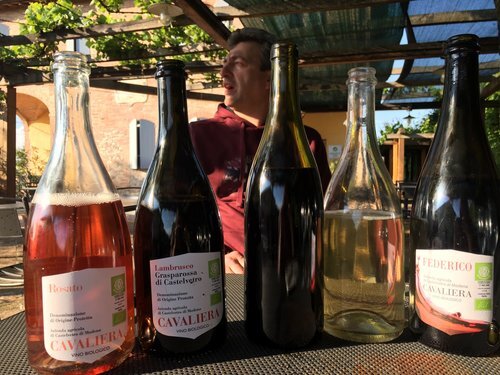Azienda Agricola Cavaliera - Emilia, Italy
Lorenzo Simoni, from our first visit
Introducing Azienda Agricola Cavaliera
We were thrilled introducing to the USA the wines of Lorenzo Simoni at Cavaliera. Lorenzo and his family make lambrusco — sparkling wine — on the outskirts of Castelvetro di Modena.
With these new wines, let us now add more detail to the story of Lambrusco. Locally it’s well-known that we are lovers of sparkling wine, and are tirelessly motivated by sniffing out previously unknown (to us) wines with bubbles in them. These explorations lead us to be the first to import the wines of Alberto Paltrinieri and Antica Corte Pallavicina over ten years ago (as well as bubbles from all across the land). Our customers have embraced these wines with ravenous thirst, words like sorbara rolling off their tongues and bottles landing on their tables. We now add wonderful lambrusco di grasparossa and pignoletto to our vocabulary.
The Cavaliera lambrusco is not “normal” lambrusco (it should be normal for wines to be this delicious), but it is authentic lambrusco. The Cavaliera wines are made to highlight the hyper-local varieties of the area of Castelvetro: lambrusco di Grasparossa, pignoletto, and trebbiano. Lambrusco is not one grape variety, grape historians estimate there actually are about 60 different varieties. Not only are these local varieties, but they are old clones of lambrusco di grasparossa (more on that later). Cavaliera’s focus is grasparossa and pignoletto — and we were blown away by the quality of both of their wines on two separate visits to Castelvetro in October 2018 and May 2019.
Cavaliera crest and lunar calendar (E&R Photo)
Lambrusco is a sparkling wine from Emilia, in Emilia-Romagna in Italy. Most American wine drinkers, and even many if not most Italian wine drinkers, know it more as a product than as a wine — an imitation of something authentic. But what is the original reason that this region of Italy produces sparkling wine?
The bubbles are a cultural remnant of forgetfulness and fullness. Originally, bubbly lambrusco was made by accident as a byproduct of the busy farmer’s life. Too many things to do! Milk the cows, cut the wheat, tend to sick dogs (that’s what the family was actually doing on our last visit back in May). There was no time to be fussy with the wine, so the wine was bottled before it was finished and continued to ferment in bottle. After continuous fermenting the wine becomes a fizzy substance: the yeast exude CO2 as a result of alcoholic fermentation. Imagine the surprise when you open a bottle and are rewarded with a rich foam! Then comes your own impatience, what can you do but drink the whole magical bottle without thinking twice? Clever winemakers and large negociant houses took this traditional “mistake” another step and mechanized the process. Enter the “product” of lambrusco and the death of authentic lambrusco.
The Simoni family’s winemaking falls somewhere between the past and the present. The family continues to runs their small farm, the products of which are found in delicious meals prepared at their Agriturismo. All of the farming is certified organic and has been since the estate’s founding in 1993. Lorenzo was an engineer and still works as an engineer (though, as he says, the farming is taking the majority of his time now). The farm is more outward-looking than the medieval farms of old, and more deliberate about making wine sparkling, but the farmer is just as busy!
The Cavaliera farm is a special place between Modena and Castelvetro di Modena. We rolled up on a sunny day to find a beautiful stone building from 1800 bustling at the seams with family members, chickens, geese, baking bread, and the best aceto balsamico (balsamic vinegar) we’ve ever tasted. Just beyond the stone house is 5 hectares of vineyards. The vineyard is well-situated to receive lots of breeze, which is important for avoiding mildew in wet Castelvetro. Nearby rivers Tiepido and Guerro laid alluvial clay and sand deposits across this soil over thousands of years. The vineyard is on a gentle slope descending and facing the south and south-east. The first vines were planted in 1993, but some of them were planted in 2008 around the same time that their young son Federico was born. When Lorenzo planted the vineyard, he took cuttings from old vineyards very close by rather than sourcing them from a nursery, so these are vines whose home in this area goes back beyond their own lifespan. He also has focused on controlling yields with these vigorous varieties and crops his vineyard about 50% less than he did when he started the project. The focus is quality, not quantity.
In May, the red stems that give lambrusco di grasparossa were just starting to turn red. By the time the fruit is harvested, the entire stem is bright red. The grasparossa grape is sought after for its muscular tannin structure that plays delightfully against the silkenly alluring aromatics.
Lorenzo’s expertise as an engineer has allowed him to finesse certain parts of his winemaking while maintaining his grounded, low-intervention ideals. Most importantly, the entire 5 hectare Cavaliera estate (including all animal and vegetable production) is organic and has been since 1993 when the family bought the estate. In the winery, Lorenzo only adds a very modest touch of sulfur (0.1% by volume) when he is racking. He controls the temperature of the tanks so that the first fermentation is carried out by native yeast. The sugar to complete the secondary fermentation is from frozen grape juice. Every modern adjunct in the winery is lovingly chosen with the intention of staying close to tradition.
Glorious day at Cavaliera
Cavaliera makes exclusively “metodo classico” lambrusco— i.e. champagne style, second fermentation in bottle, with disgorgement of lees. This style is more refined than “metodo ancestrale”, wherein wine is bottled unfinished and develops fizz as described above. Lorenzo has visited Champagne several times and wants to come close to their process with his own. In order to streamline this process, Lorenzo built his own disgorging machine. Pop a bottle in, some gears and hydraulics move, and boom — the dead yeast are out of the bottle and the wine is ready to drink. It is much cleaner and much faster than hand-disgorging, and allows him to make wine in the style he prefers. There is no dosage (no sugar added as in so many wines like these) in any of the wines and all of them are bone-dry. Several producers in the area, including aforementioned Alberto Paltrinieri, bring their wine to Lorenzo to be disgorged.
Lorenzo’s wines sing of moving tradition in Lambrusco. The wine is no longer as simplistic as the “farmer fizz” of the old days, but wines like Lorenzo’s are wines ingested and revered like food. One sip of his wine and you will forget the naysayers who fling insults about Lambrusco’s dull sweetness (yes, they’re still out there but this is not what that is). These wines are complex, dry, and gracefully traditional. Lorenzo acknowledges that the large scale industrial wines of lambrusco are helpful for spreading the word of small producers like himself. Times are changing, and Lambrusco is getting better.
(LB)
Click on each wine for more detail.










